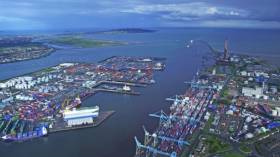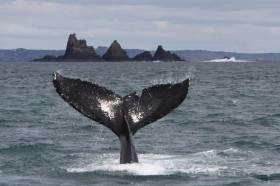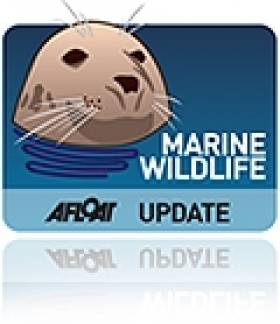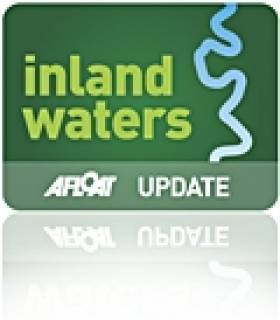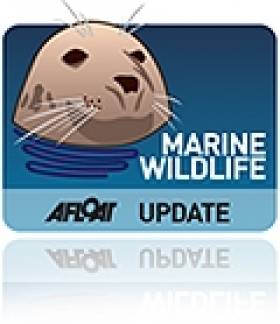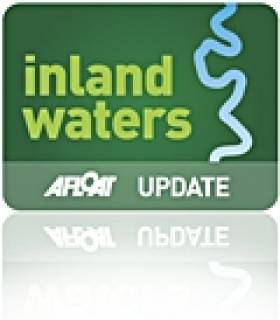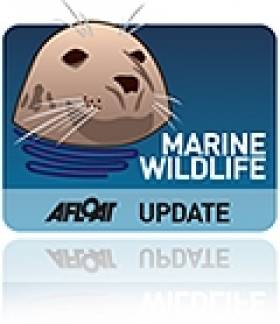Displaying items by tag: biodiversity
Call For Entries In New Biodiversity Awards Scheme
#Biodiversity - The Irish Wildlife Trust and Dublin Port Company today (Thursday 25 October) launched the Together for Biodiversity Awards with the Minister for Culture, Heritage & the Gaeltacht, Josepha Madigan.
The awards are being run by the Irish Wildlife Trust, as part of the National Biodiversity Conference next February, and supported by Dublin Port Company.
This is the first Irish awards programme of its kind dedicated solely to recognising and funding biodiversity champions in our society.
The Irish Wildlife Trust is now calling on community groups, schools, farmers and individuals to enter the Together for Biodiversity Awards, have their work recognised and be in with the chance to win funding for future biodiversity projects.
The Together for Biodiversity Awards are an opportunity to celebrate the fantastic work carried out by communities across Ireland to protect our natural environment.
Individuals and communities all over Ireland are doing their bit to help save biodiversity through local projects.
Have you or your community been involved in a project to help protect local wildlife or habitats this year? Perhaps you planted a school wildlife garden, made your village more pollinator0friendly or helped protect a local wetland.
If so, all you have to do to enter is tell all about the work you carried out and how it helped your local biodiversity.
There are categories for community groups, farmers, schools and individual biodiversity champions. Finalists from each category will be invited to the National Biodiversity Conference to highlight their work. Winners will be announced at the conference with a prize of €2,000 for each category winner.
Minister Madigan said: “The Together for Biodiversity Awards are a fantastic opportunity to celebrate the wealth of work being done at local level to protect wildlife and create and restore habitats across Ireland.”
Kieran Flood, co-ordinator with the Irish Wildlife Trust, added: “It is only with the help of local biodiversity champions that will we have a chance of halting biodiversity loss in Ireland, so we are delighted to be celebrating their efforts through the Together for Biodiversity Awards.”
Eamonn O’Reilly of the Dublin Port Company said it is delighted to sponsor the Together for Biodiversity Awards.
“The port is not only a hive of activity for ships, containers and cranes, but also home to an array of birds, marine life, flora and fauna that form part of the Dublin Bay biosphere.
“We are committed to working with a range of organisations and conservationists to better understand and protect our natural environment, and we know that there are countless groups and individuals with the same ambition.
“The awards will shine a light on those doing brilliant work to protect biodiversity right around the country and help support future projects too,” O’Reilly said.
The Together for Biodiversity Awards are part of the National Biodiversity Conference, which takes place at Dublin Castle on 20-21 February 2019 and is being organised by the National Parks and Wildlife Service and the Irish Forum on Natural Capital.
For more details on how to enter the awards visit iwt.ie/biodiversity-awards
Have A Whale Of A Time This National Biodiversity Week
#Biodiversity - Whale watches at Cloghna Head and Loop Head cap off a packed lineup of events for National Biodiversity Week, which began this past weekend.
The nine-day initiative aims to connect people with the natural world and communicate the importance of playing our part in protecting Ireland’s biodiversity — from bat boxes to beekeeping and much more.
Among its own series of events for the week, the Irish Whale and Dolphin Group (IWDG) will be hosting whale watches at Cloghna Head in Co Cork on Saturday 26 May, and Loop Head in Co Clare on Sunday 27 May.
Other marine wildlife related events include a celebration of Lough Foyle’s biodiversity lunchtime today (Tuesday 22 May) at Moville Town Library.
Also happening today is an event hosted by the Dublin Civic Trust on the River Liffey as an important wildlife habitat in the heart of the capital.
See the full list of events on the National Biodiversity Week website HERE.
Coastline Comes Alive For National Biodiversity Week
#MarineWildlife - Whether you’re cruising around the coast or staying put on dry land, there’s much to see and explore during National Biodiversity Week, which kicked off yesterday (Friday 19 May) and continues till next weekend.
Among the 50 free events nationwide are two whale watches hosted by the Irish Whale and Dolphin Group (IWDG), today (Saturday 20 May) at Cloghna Head in Co Cork and next Sunday (28 May) at Loop Head in Co Clare.
The IWDG is also holding talks on Ireland’s cetaceans — no doubt with reports from the latest Celtic Mist cruise — in Fenit, Co Kerry (on Sunday 21 May) and Kilrush, Co Clare (Saturday 27 May), the latter of which will discuss the unique population of Shannon dolphins.
Next Saturday also sees Galway Bay seashore walks at Grattan Shore in Salthill, in association with Galway Atlantaquaria, to explore the area’s marine wildlife.
Coast Monkey lists its top picks from the week’s activities, including a nature walk on Inch Beach tomorrow (Sunday 21 May), rock pool exploration at Hook Head Lighthouse (Sunday 28 May) and a biodiversity walk at the Wicklow Murrough (Friday 26 May) led by marine biologist Karin Dubsky.
Climate Change Challenge For Ireland's Biodiversity
#Biodiversity - Climate change is putting increasing pressure on natural habitats for Irish wildlife, particularly where biodiversity is affected by human action.
That's the conclusion of the first National Biodiversity Indicators report, which sought to measure changes affecting marine wildlife and inland species alike in terms of temperature, rainfall and other factors, as The Irish Times reports.
Dr Tomás Murray, an ecologist with the National Biodiversity Data Centre who co-ordinated the report with Deirdre Lynn of the National Parks and Wildlife Service, shared his alarm that only five per cent of Ireland's known species have been assessed for their conservation status.
The Irish Times has more on the story HERE.
#Biodiversity - Coastwatch volunteers taking part in events for National Biodiversity Week have discovered a massive honeycomb reef as much as a kilometre long in the Waterford Estuary.
Members of the public began checking the shore between Hook Head in Co Wexford and Annestown in Co Waterford on Monday 18 May, an area that has previously shown signs of honeycomb reefs.
But volunteers were astounded to make this latest massive discovery, and Coastwatch members are working to ascertain if it might be the biggest reef of its kind in the world, a record currently held by Saint-Malo in Brittany.
Karen Dubsky of Coastwatch Europe said "first results look very encouraging. We are looking for more surveyors to give an hour and search their shore."
Events continue till Monday 1 June for Ireland's National Biodiversity Week 2015, with today (Friday 22 May) being International Day for Biological Diversity.
Upcoming flagship events include a marine wildlife-watching trip to Lambay Island next Wednesday 27 May, but the event calendar lists a whole host of activities both around the coast and inland throughout the country.
Waterways Ireland Consults On Heritage & Biodiversity Plan
#InlandWaters - Waterways Ireland is inviting submissions from all interested parties, groups and individuals before commencing the development of a Heritage & Biodiversity Plan for the waterways under its care.
The cross-border agency for Ireland's inland waterways is particularly seeking input into the issues and/or projects that should be addressed.
Beginning tomorrow Monday 20 October and running till 12 January 2015, interested stakeholders can complete an online survey (or submit by email or post) to gauge waterways users' vision for the natural and cultural heritage of our rivers, lakes and canals.
Future consultations will seek input on Waterways Ireland's proposed Disability Action Plan, new Lough Erne bye-laws, and Environmental and Heritage Policy going forward. For more see the Waterways Ireland website HERE.
NI Marine Bill Progress Marks 'Turning Point'
#MarineWildlife - The Northern Ireland Environment Minister says the new Marine Bill put before Stormont marks a "turning point" for the North.
As 4NI reports, this week saw the fourth stage of the Marine Bill in the NI Assembly as well as the launch of a consultation strategy for Marine Protection Areas (MPAs).
Should it be enacted in legislation, the Marine Bill - strongly supported by the RSPB among others - would give the Assembly powers to select and manage Marine Conservation Zones (MCZs) to safeguard the North's marine biodiversity.
Minister Alex Attwood commented: "Northern Ireland’s seas are home to some of the world's most spectacular wildlife and habitats, and have the potential to power our nation through wind and wave and create thousands of new jobs.
"We have reached a turning point and must modernise in order to meet increasing and competing demands on our seas."
The Marine Bill also provides for the creation of a National Maritime Plan which covers all aspects of the marine environment from wildlife to investment in tidal and offshore wind power.
4NI has much more on the story HERE.
IFI Addresses EU Parliament on Invasive Alien Species
#InvasiveSpecies - Dr Joe Caffrey of Inland Fisheries Ireland (IFI) presented Ireland’s position on the threat of invasive alien species to Ireland's waterways at a high-level debate at the European Parliament in Brussels on 21 February last.
Discussions centred on the issue of invasive alien species in Europe and the development of an EU policy instrument to tackle the threats.
The debate, titled ’Biodiversity’s Ticking Time Bomb: Understanding and Addressing the Problem of Invasive Species in Europe’, was organised via the International Union for Conservation of Nature (IUCN) and Birdlife, with the support of the European Habitats Forum.
Dr Caffrey was one of nine speakers who presented to the large gathering where he addressed the theme ‘The challenges and opportunities of member states in implementing EU legal measures: the example of Ireland’.
The talks were followed by a highly interactive panel discussion during which the pros and cons of a dedicated EU legislative instrument on invasive alien marine species were debated. The results of EU deliberations on this theme will emerge in the coming months when a consultation document will be released.
In the meantime, IFI and EIFAAC will host the FINS (Freshwater Invasives – Networking for Strategy) Conference in Galway on 9-11 April which will address key topics relating to freshwater invasive species and harmful aquatic pathogens.
The conference is attracting a large international audience of policy makers in this area. The primary objective of the conference is to provide a forum where international scientists, policy makers and stakeholders will address designated themes with a view to informing management and policy development in this increasingly important area.
Minister Fergus O'Dowd, who recently launched the world's first angling kit to combat invasive species, said of the conference: “Invasive species cause some €12.5 billion worth of damage each year in the European Union alone and are a serious threat to native biodiversity across the continent. IFI is keenly aware of the threat to our own natural resources, particularly to our economy, health and recreational activities.
“I want to congratulate IFI on the lead it has taken in its scientific, practical and proactive approach to this issue, working with stakeholders on the front line to ensure that biosecurity awareness is paramount. They are also bringing Ireland’s first-hand experience to Europe and adding to the positive debate on an EU wide cooperative framework to safeguard our natural resources through legislation and knowledge transfer."
The FINS conference will be held at the Galway Bay Hotel and Conference Centre in Salthill, Galway, Ireland from 9-11 April 2013. For more details visit the FINS Conference website.
Illustrated Talks On Shannon's Natural Heritage Throughout February
#Shannon - MulkearLIFE and Inland Fisheries Ireland have announced details of a series of free illustrated talks taking place in Limerick throughout February on the extraordinarily rich natural heritage of Ireland, and in particular the Lower Shannon.
The talks form part of MulkearLIFE’s Environmental Education Programme, an outreach programme in local schools and the local community in the Mulkear catchment. The series will be hosted over four Tuesday evenings and will include leading experts sharing their knowledge on farming and conservation and biodiversity management.
Among the talks will be the fascinating story of Atlantic salmon in the River Shannon, presented by Dr Phil McGinnity on 12 February. Dr McGinnity is Beaufort Principal Investigator with UCC’s Aquaculture & Fisheries Development Centre, with more than 23 ears of experience in fisheries science and management, and his talk will outline new and extremely exciting research on the genetic make-up of various salmon types found in the Shannon. He will also examine the history of salmon fisheries on the Shannon. His talk should be of particular interest to anglers far and wide and anyone with a general interest in Irish biodiversity.
On 19 February, Colette O’Flynn will relate the scary story of what is emerging in terms invasive non-native animals and plants arriving into Ireland's coastal and inland waterways. O’Flynn is a research officer with the National Biodiversity Data Centre in Waterford. She manages the National Invasive Species Database for Ireland, which tracks non-native invasive animals and plants in Ireland. She is involved with many European and international invasive species information networks and has been involved with invasive species policy development for the European Commission. She previously worked in various areas in biodiversity education and awareness. Her talk should be of interest to a wide variety of people, especially anglers and those with an interest in Irish wildlife and general biodiversity.
The series of illustrated talks will conclude on 26 February with a talk by Eamon Cusack on building partnerships for sustainable fisheries on the Lower Shannon. Cusack is extremely well known in the fisheries world with over 35 years experience in inland fisheries management. As the former CEO of the Shannon Regional Fisheries Board, he encountered many of the challenges facing fisheries management, and has hands-on experience of policy development, strategic management, change management, enforcement, development and rehabilitation. This talk will focus on his recent work to bring together anglers and the ESB to provide to build effective and durable partnerships for sustainable fisheries. His talk should be of particular interest to local anglers and anyone with a general interest in conservation management and planning.
But the series begins on 5 February with a talk presented by Ruairí Ó Conchúir on conservation farming and biodiversity in the Upper Mulkear Catchment. Ó Conchúir is the manager of MulkearLIFE and has worked in land care management, rural development, farming for conservation and fisheries restoration work for over 20 years, including 10 years in Southern Africa. His talk will focus on the work of MulkearLIFE with farmers over the past three years, with a particular emphasis on partnership work with farmers to improve local habitats. The talk will also attempt to map out where upland farming in Ireland is heading and review work in other uplands parts of Ireland, and outline the likely implications are for upland communities, related farming and habitats post 2014. His talk should be of particular interest to anyone with a general interest in farming, the Irish uplands and the future of EU agri-environmental supports post 2014.
The venue for all talks is the Inland Fisheries Ireland office at Ashbourne Business Park, Dock Road, Limerick. There is plenty of free parking at the front of the building at night. Talks will commence at 8pm sharp and there is free admission to all talks. Further information regarding any of the talks may be obtained from the project [email protected] or from MulkearLIFE, Inland Fisheries Ireland (Limerick) at 061 300 238 or 087 062 5582.
Marine Mammal Sightings Needed for Irish 'Atlas' of Species
#MARINE WILDLIFE - Spotters of marine mammals such as whales and dolpins are among the country's wildlife enthusiasts being called to help compile an Atlas of Mammals in Ireland.
According to The Irish Times, more than 5,000 sightings have been logged already, but the National Biodiversity Data Centre (NBDC) needs more, and is asking members of the public, scientists and anyone with an interest in nature to send in details of whatever mammals they see.
Mammals have been chosen for the project because there is surprisingly "no or little data in terms of their distribution" despite being so commonly sighted, said NBDC director Liam Lysaght.
“We now have a system in place where we can plot the distribution of say the blue whale and the pygmy shrew."
In particular, the project aims to get better picture of the distribution of introduced species such as brown rats or mink, which can have a disastrous impact on nesting seabird colonies.
The Irish Times has much more on the story HERE.


























